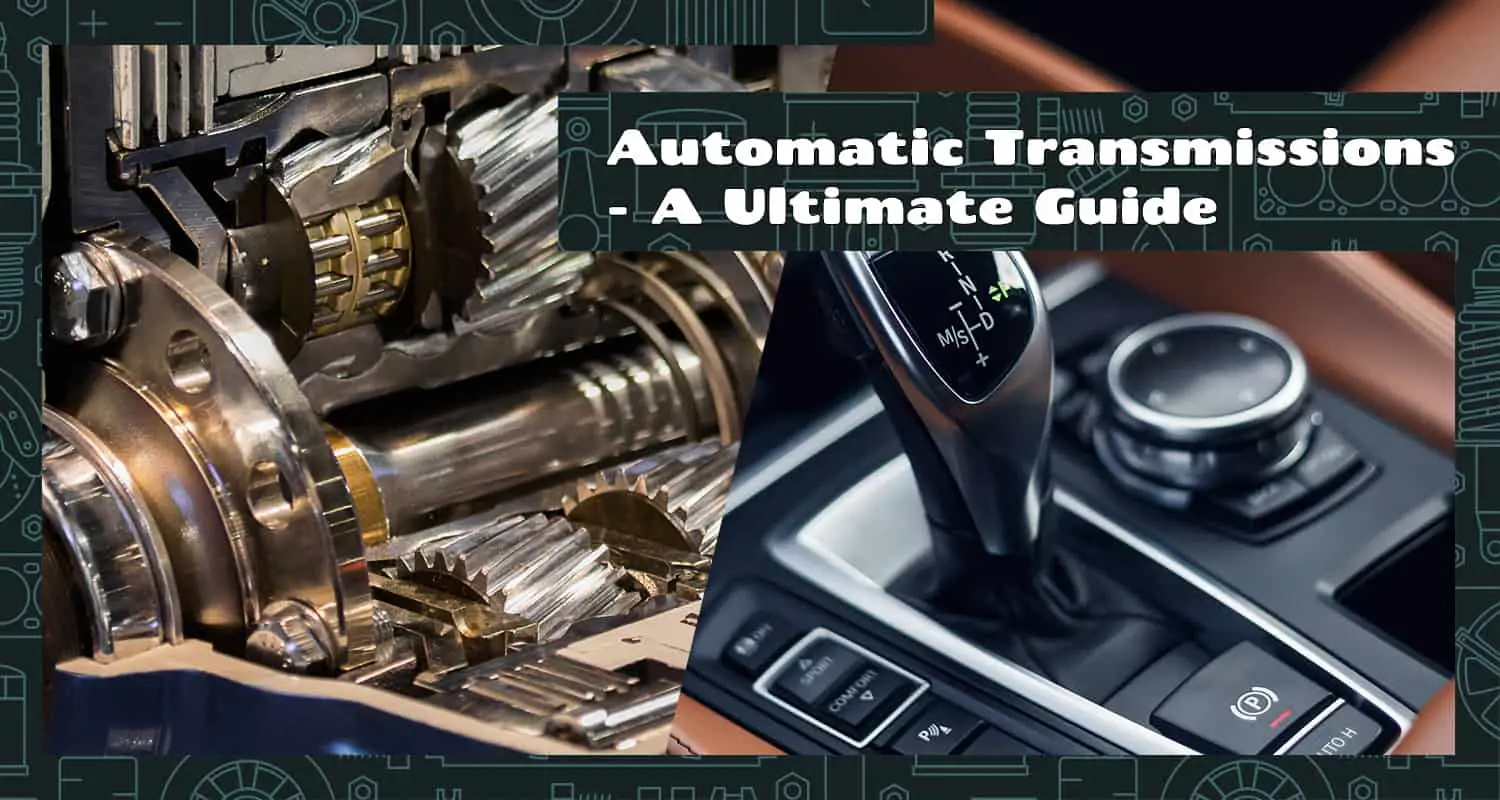Automatic transmissions let your car switch gears without you having to do it manually, so you can enjoy your drive without worrying about when to shift gears. Whether you’ve driven a car or not, you might have heard people talk about “manual” and “automatic” cars. In automatic ones, the transmission does a big job!
In this article, we’re going to dive into the world of automatic transmissions. We’ll explain what they are, how they work, different types of automatic transmissions, and some more.
What Are Automatic Transmissions?
Automatic transmissions have a crucial role in a car’s operation. They help transmit the engine’s power to the car’s wheels. In other words, they help your car move! By automatically changing gears, they ensure that the engine runs efficiently at all speeds.
If you’re driving at a high speed on the highway, the transmission shifts to a high gear. But if you’re moving slowly in heavy traffic, it shifts to low gear. This adaptability allows the engine to perform effectively in all conditions, which can save fuel and reduce wear and tear on the engine.
Automatic transmissions also make driving easier, especially for new drivers or in heavy traffic. Since the transmission shifts gears on its own, the driver doesn’t have to worry about using a clutch pedal and shifting gears manually.
Automatic Transmission Parts
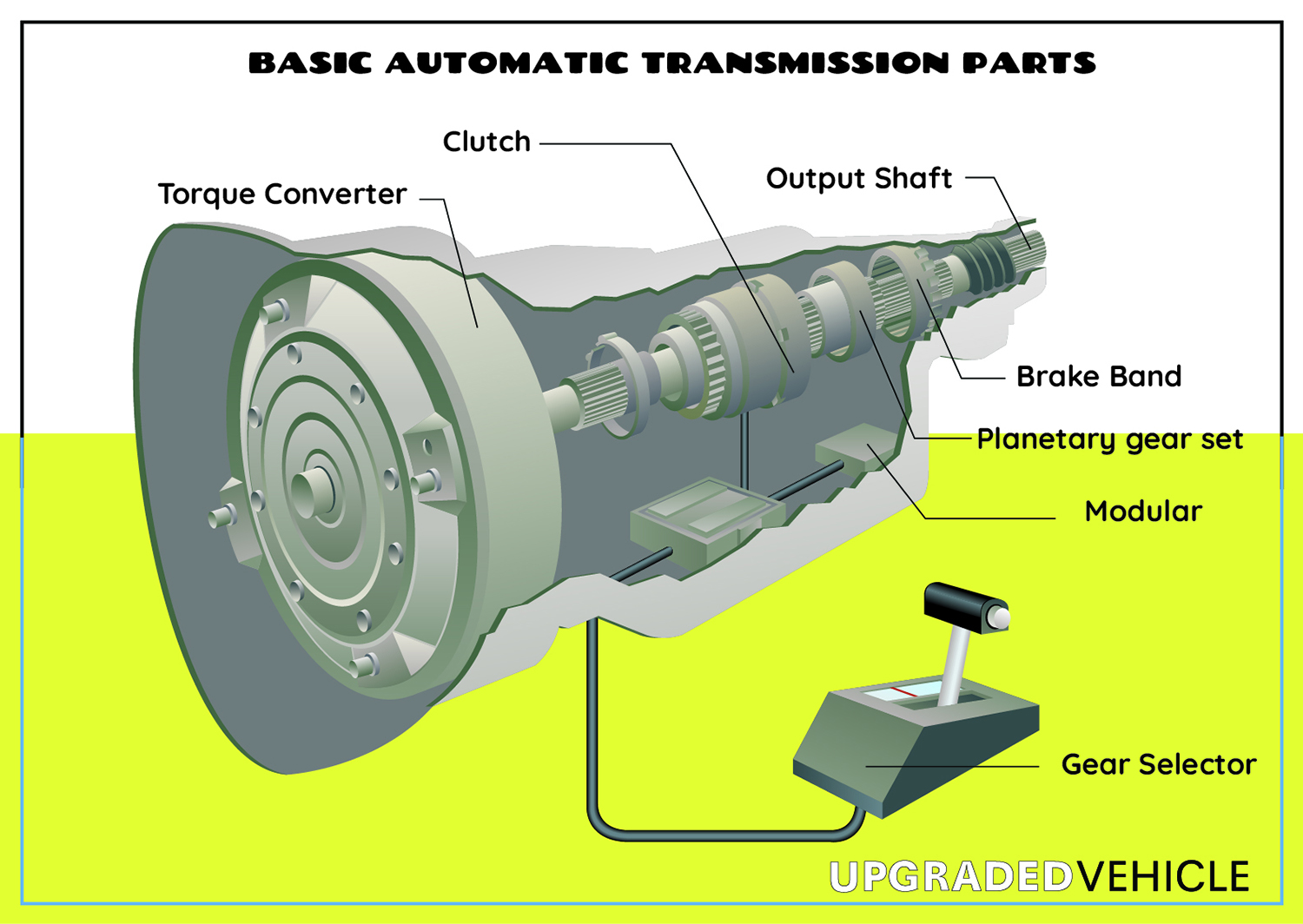
An automatic transmission is a complex piece of machinery that uses numerous components to change gears smoothly and efficiently. Now, let’s break down how it achieves this.
1. Torque Converter
One key part of an automatic transmission is the torque converter. The torque converter connects the engine to the transmission. It uses transmission fluid to transfer power from the engine to the transmission. When you’re stopped at a light, the torque converter allows the engine to keep running even though the car isn’t moving.
Inside the torque converter are two fan-like parts. One is connected to the engine, and the other to the transmission. When the engine turns the first part, it moves the fluid, which turns the second part and drives the transmission.
2. Planetary Gear Sets
A planetary gear set consists of three parts: a central “sun” gear, “planet” gears that orbit around the sun gear, and a “ring” gear that encloses the others. This is what actually changes the gears.
By locking different parts of the gear set, the transmission can create different gear ratios without shifting gears in the traditional sense. It’s a clever system that allows for smooth and seamless gear changes.
3. Transmission Fluid
Transmission fluid lubricates the moving parts, preventing wear and tear. It also serves as the hydraulic fluid that the transmission control unit (TCU), a type of computer, uses to control the gears. The fluid gets pumped under pressure to different parts of the transmission to engage or disengage the gears.
Keeping the transmission fluid clean and at the right level is important for the smooth operation of the transmission. Over time, the fluid can get dirty or break down, and low fluid levels can prevent the transmission from working properly.
4. Seals and gaskets
Seals and gaskets in an automatic transmission play a crucial role in maintaining the right pressure and preventing leaks. They ensure that the transmission fluid stays inside and doesn’t escape. If these fail, fluid can leak, causing various transmission problems and possible damage.
5. Governor and Modulator
The governor and modulator are sensors that inform the transmission when to shift gears. The governor monitors the vehicle speed while the modulator checks the engine load (how hard the engine is working). Together, they provide necessary data to the hydraulic system for efficient gear shifting.
6. Clutches, Bands, and Servos
Clutches, bands, and servos are essential parts in controlling gear shifting. Clutches and bands selectively engage and disengage parts of the gear set, altering the gear ratios. Servos are hydraulic devices that control the clutches and bands. Their coordinated operation ensures a smooth ride by providing seamless gear changes.
7. Output Shaft
The output shaft is the final step in the power flow of the transmission system. After the transmission’s internal components have processed the engine’s power and determined the correct gear ratio, the output shaft transfers this power to the vehicle’s axles. It directly influences the car’s speed and torque output.
8. Shift Points and TCU
The shift points are specific speeds where the transmission changes gears. In an automatic transmission, the TCU decides these shift points based on the car’s speed and the load on the engine. For example, when you’re accelerating hard to merge onto a freeway, the TCU might delay shifting to a higher gear to provide more power.
On the other hand, if you’re just cruising along a flat road, the TCU will shift to a higher gear sooner, focusing more on fuel efficiency.
The TCU uses sensors in the engine and transmission to make these decisions. It constantly monitors conditions like engine speed, vehicle speed, throttle position (how far down you’re pressing the gas pedal), and others. This information helps it decide when to shift gears and which gear to select.
How Does an Automatic Transmission Work?
So how does it all come together? Here’s a comprehensive guide on how automatic transmissions work.
- When you start the car and press the accelerator, the engine creates power. The amount of power depends on how much you press the accelerator pedal.
- The engine’s power then goes to the torque converter, which uses transmission fluid to transfer the power, essentially converting the engine’s output into a form that the transmission can use.
- The power is then passed on to the transmission. The transmission’s main job is to control how much of that power goes to your car’s wheels. This is crucial for keeping the engine working efficiently and maintaining the car’s speed.
- Inside the transmission, a planetary gear set changes the transmission’s gear ratio, which is the difference between how fast the engine is turning and how fast the wheels are turning. This change in gear ratio is what we usually call “shifting gears.”
- The TCU decides when to change the gears. It uses information from the car’s speed and engine load to determine the best time to shift gears.
- The changed gear ratio now controls how much of the engine’s power goes to the wheels. For instance, if the car is just starting from a stop, the TCU would have chosen a low gear ratio. This ratio allows a high amount of the engine’s power (but at a low speed) to go to the wheels. As the car speeds up, the TCU gradually changes to higher gear ratios, allowing less power but higher speed to go to the wheels.
- This process continues as long as the car is running, with the TCU constantly making adjustments. It changes the gear ratio based on factors such as how fast you’re going, how hard the engine is working, and whether you’re going uphill, downhill, or driving on flat ground.
History of the Automatic Transmission
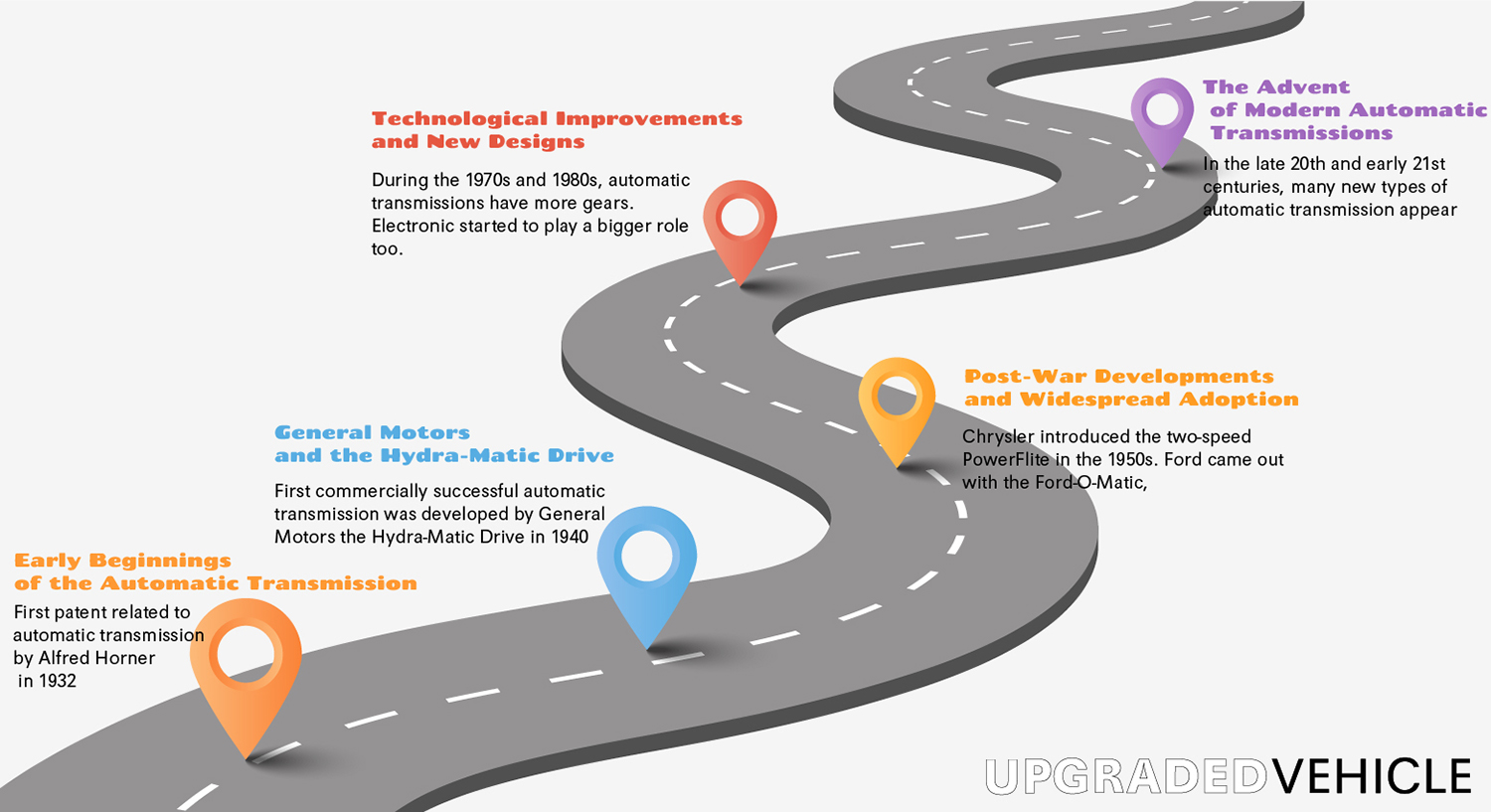
The automatic transmission is a pivotal invention in automotive history. It has made driving simpler and more accessible to people around the world. Understanding the history of the automatic transmission gives us a deeper appreciation of how far car technology has come and where it might go next.
The Early Beginnings of the Automatic Transmission
The journey towards automatic transmissions began in the early 20th century. The first patent related to automatic transmission technology was filed by a Canadian inventor named Alfred Horner Munro in 1932. Munro’s design was based on compressed air and wasn’t very practical, but it started the development of automatic transmissions.
General Motors and the Hydra-Matic Drive
The first commercially successful automatic transmission was developed by General Motors the Hydra-Matic Drive in 1940. This four-speed transmission was first used in the Oldsmobile. Unlike manual transmissions, it didn’t require a clutch pedal. The Hydra-Matic Drive was the first mass-produced transmission that could change gears by itself, setting a new standard in the industry.
Post-War Developments and Widespread Adoption
After World War II, other automobile manufacturers started developing their own automatic transmissions. Chrysler introduced the two-speed PowerFlite in the 1950s. Ford came out with the Ford-O-Matic, also a two-speed automatic transmission.
By 1957, automatic transmissions became the dominant transmission type in new US cars. They made driving more convenient, especially in city conditions where frequent stops and starts made manual gear shifting tedious. The desire for ease and comfort pushed the popularity of cars with automatic transmissions.
Technological Improvements and New Designs
During the 1970s and 1980s, automatic transmissions became more sophisticated. They now had more gears—three, four, even five. More gears meant smoother gear changes and better fuel efficiency.
Electronics started to play a bigger role too. Sensors and microprocessors, part of a car’s onboard computer system, began to manage the transmission’s operation. This allowed for more precise control of gear shifting, improving performance and efficiency.
The Advent of Modern Automatic Transmissions
In the late 20th and early 21st centuries, we’ve seen several new types of automatic transmissions. Continuously Variable Transmissions (CVTs) use a belt and pulley system instead of gears, allowing for an infinite number of gear ratios. This can improve fuel efficiency and provide smooth acceleration.
In recent years, automatic transmissions with even more gears have been developed. Some models now have eight, nine, or even ten gears. More gears allow the engine to run more efficiently, further improving fuel economy.
Types of Automatic Transmissions
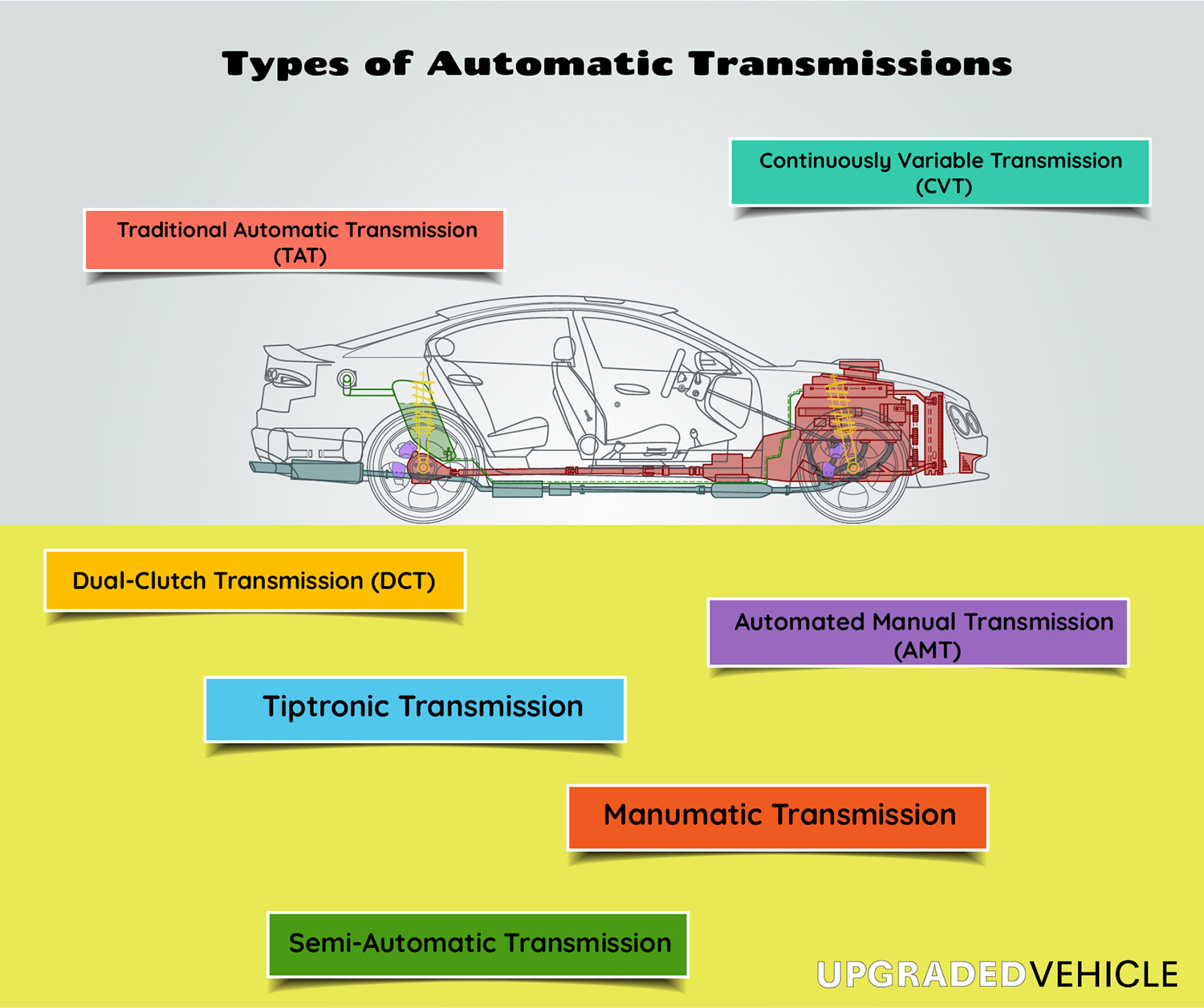
Automatic transmissions have evolved over time, resulting in several different types. Each type has its unique design and way of operation.
1. Traditional Automatic Transmission (TAT)
Traditional Automatic Transmissions, often referred to as torque converter automatics, are the most common type. They use a fluid coupling called a torque converter and a set of planetary gears to transmit power from the engine to the wheels. The transmission control unit manages gear shifting based on vehicle speed and engine load.
2. Continuously Variable Transmission (CVT)
Continuously Variable Transmissions are a type of automatic transmission that don’t use traditional gears. Instead, they use a system of belts and pulleys to produce a continuous range of gear ratios. This results in smooth, seamless acceleration with no noticeable gear shifts. CVTs are commonly found in compact cars because they are light and offer great fuel efficiency.
3. Dual-Clutch Transmission (DCT)
Dual-Clutch Transmissions, also known as Direct-Shift Gearboxes (DSG), use two separate clutches for odd and even gears. This design allows one gear to engage while the other disengages, resulting in super quick gear shifts. DCTs can be found in many high-performance cars due to their speed and efficiency.
4. Automated Manual Transmission (AMT)
Automated Manual Transmissions function similarly to manual transmissions but without the need for a clutch pedal or gear stick. Instead, the clutch operation and gear shifting are controlled electronically. AMTs offer the fuel efficiency of a manual transmission with the ease of use of an automatic, but they can sometimes be less smooth in their operation.
5. Tiptronic Transmission
Tiptronic Transmissions are a type of automatic transmission that allows the driver to manually shift gears when desired. While it operates automatically by default, the driver can override the system to control gear shifts manually, offering more control over the vehicle’s performance.
6. Manumatic Transmission
Manumatic transmissions are another type of automatic transmission that allows manual shifting. Similar to Tiptronic, manumatic transmissions usually operate in an automatic mode, but the driver can switch to a manual mode when more control is desired.
7. Semi-Automatic Transmission
Semi-Automatic Transmissions are somewhat of a hybrid between manual and automatic transmissions. They have a manual gearbox and require the driver to change gears, but they don’t require a clutch pedal. The clutch is operated automatically whenever the driver changes gears.
Automatic Transmission vs. Other Transmissions
When it comes to vehicles, there’s more than one type of transmission. Each has its unique features and benefits. In this section, we’ll compare automatic transmissions with other common types, like manual and semi-automatic transmissions, to help you understand the differences.
Automatic vs. Manual Transmissions
- Ease of Use: Automatic transmissions win in terms of ease of use. They change gears on their own, so you don’t have to worry about the clutch pedal or figuring out when to shift gears. In contrast, manual transmissions require more driver involvement. You have to coordinate the clutch and gear stick, which can be challenging, especially for new drivers.
- Control: However, manual transmissions offer more control. They allow drivers to choose the exact moment to shift gears. This feature can be beneficial in performance driving or when driving in difficult conditions like steep hills or heavy traffic.
- Fuel Efficiency: Historically, manual transmissions were known to be more fuel-efficient. But modern automatic transmissions, especially those with more gears and advanced technology, have significantly closed this gap.
Automatic vs. Semi-Automatic Transmissions
- Driver Involvement: In terms of driver involvement, semi-automatic transmissions are similar to manual transmissions since you need to select the gears. However, they are easier to use since they don’t have a clutch pedal.
- Control and Ease of Use: The semi-automatic transmission tries to balance the control of manual transmissions with the ease of automatic ones. You get more control than with a fully automatic transmission, but it’s less physically demanding than a manual transmission.
Automatic vs. CTV
- Smoothness: CVTs are incredibly smooth. They don’t have individual gears, so you won’t feel the gear shifts as you accelerate. Automatic transmissions, even though they shift gears smoothly, can’t match the seamless acceleration of CVTs.
- Efficiency: CVTs are often more fuel-efficient than conventional automatic transmissions because they can always adjust to provide the optimal gear ratio.
Benefits and Disadvantages of the Automatic Transmission
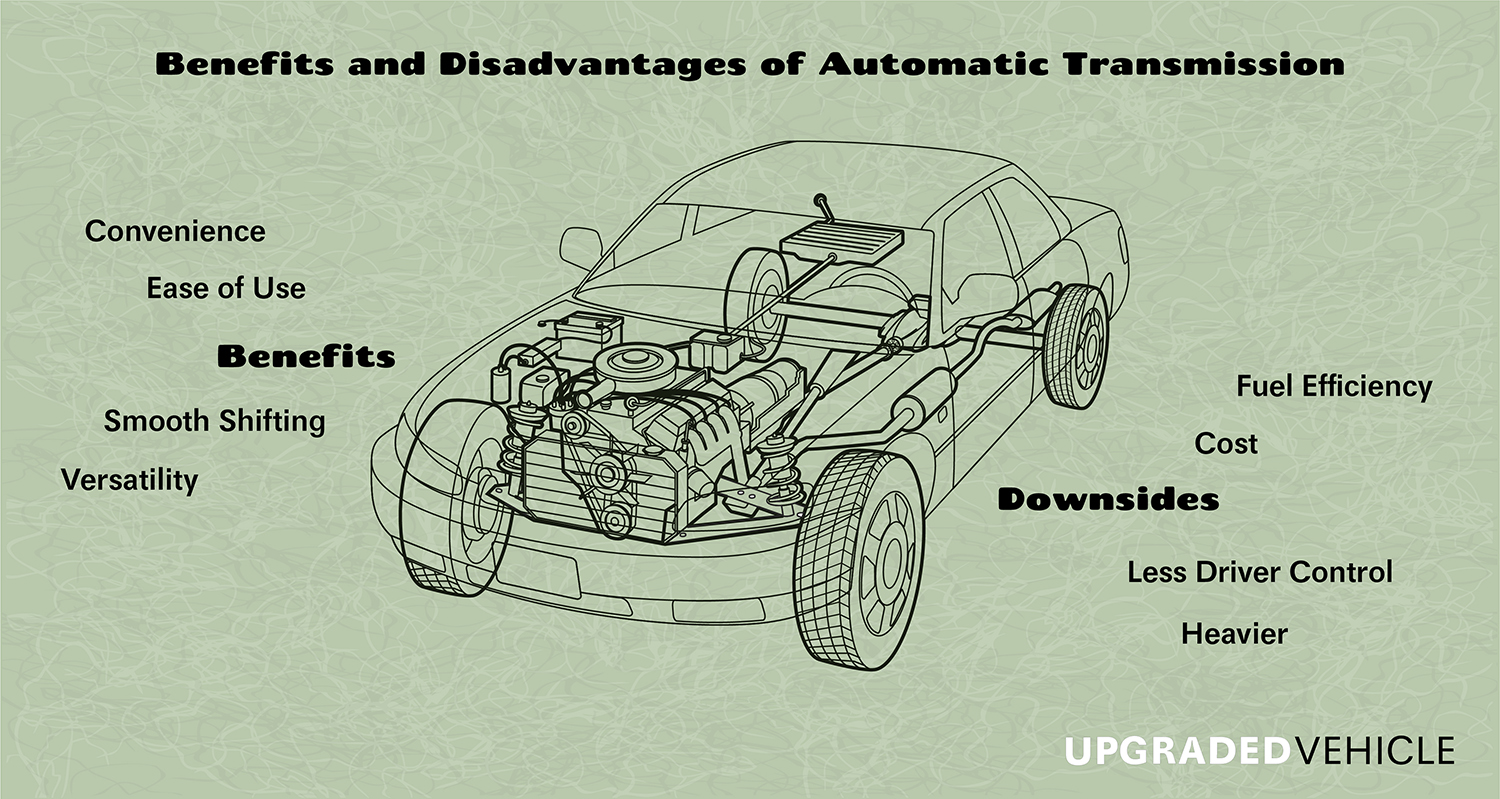
Like anything else, automatic transmissions come with their benefits and downsides. In this section, we’ll explore these aspects to provide a balanced view and help you make an informed decision when choosing a vehicle.
Benefits of Automatic Transmission
Automatic transmissions have a lot to offer. Here are some of the most significant advantages.
1. Ease of Use
Automatic transmissions are easy to use, especially for new or inexperienced drivers. You don’t have to worry about shifting gears or operating a clutch, which makes driving less stressful. This feature is particularly beneficial in heavy traffic, where constantly having to shift gears in a manual vehicle can be tiring.
2. Convenience
Automatic transmissions take care of all the gear changes for you, so you can focus more on the road and other aspects of driving. This means less distraction and potentially safer driving.
3. Smooth Shifting
Modern automatic transmissions can shift gears very smoothly, making the drive more comfortable. This is especially true in high-end vehicles with advanced transmission systems.
4. Versatility
Automatic transmissions can adapt to various driving conditions without any extra effort from the driver. Whether you’re going uphill, downhill, or driving at high speeds on a highway, the transmission will select the appropriate gear for optimal performance.
Disadvantages of Automatic Transmission
Despite their advantages, automatic transmissions also have a few drawbacks to consider.
1. Cost
Automatic transmissions are generally more expensive than their manual counterparts. This cost applies not only to the initial vehicle price but also to maintenance and repair costs, as automatic transmissions are more complex and can be more expensive to fix.
2. Fuel Efficiency
While modern automatic transmissions have become more fuel-efficient, they still generally consume more fuel than manual transmissions. The difference is not as stark as it once was, but it still exists.
3. Less Driver Control
With an automatic transmission, you have less direct control over your vehicle. While this won’t be a problem for most drivers, those who prefer a more engaged driving experience might find this to be a downside.
4. Heavier
Automatic transmissions are typically heavier than manual ones, which could slightly affect the vehicle’s performance and fuel efficiency.
What Are the Best Automatic Transmission Brands?
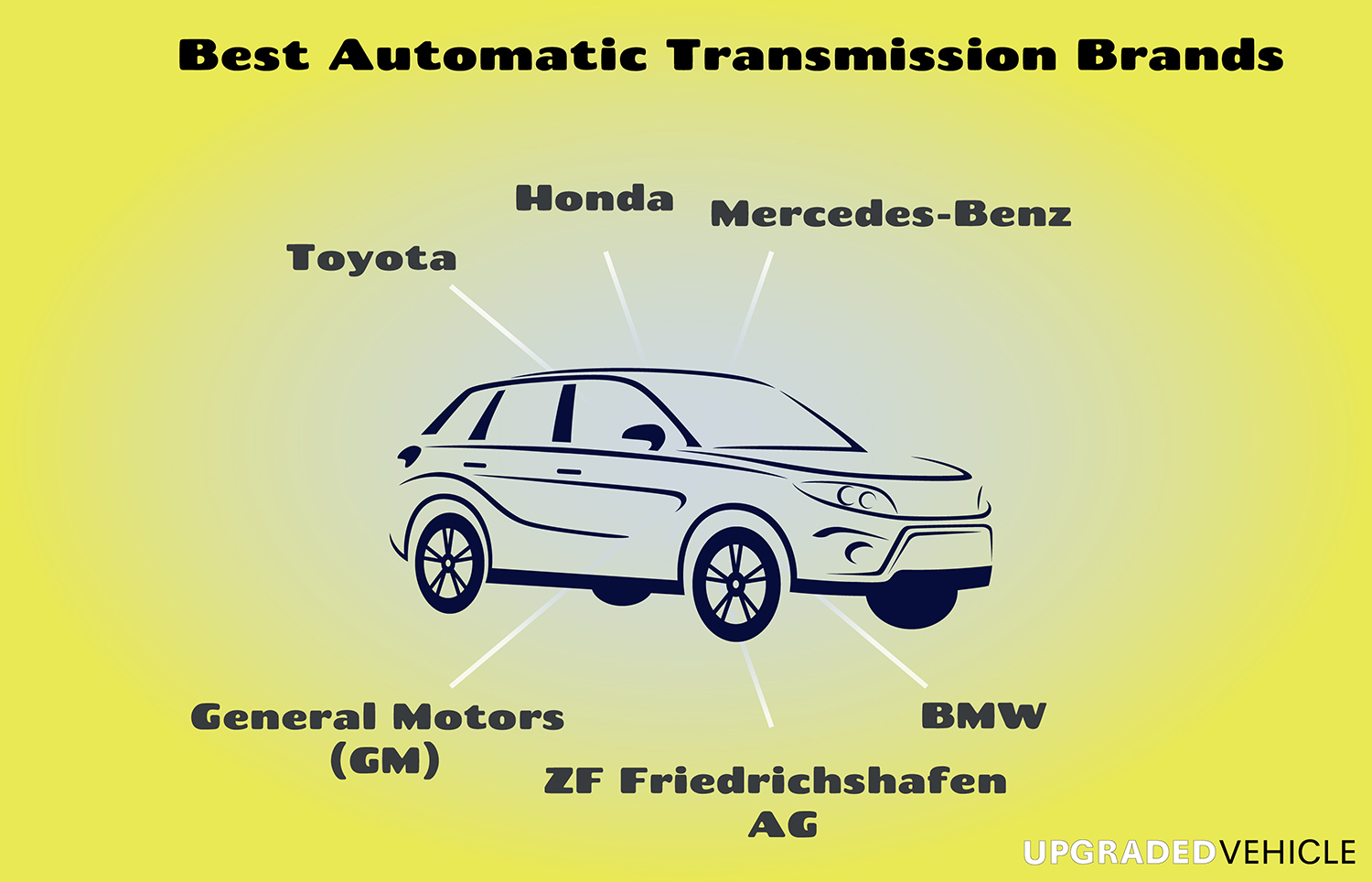
When it comes to automatic transmissions, some brands have made a name for themselves by producing reliable, efficient, and high-performing systems. Here, we’ll take a closer look at some of these top brands and what makes their automatic transmissions stand out.
Toyota
Toyota is well-known for the reliability of its vehicles, and its automatic transmissions are no exception. Many Toyota models use a CVT that provides smooth performance and great fuel efficiency. The brand’s reputation for long-lasting vehicles makes it a favorite among many car owners.
Honda
Honda is another brand with a strong reputation for reliability, and its automatic transmissions contribute to this reputation. Honda’s automatic transmissions are designed for smooth, efficient performance and are generally regarded as being long-lasting with proper care and maintenance.
Mercedes-Benz
When it comes to luxury vehicles, Mercedes-Benz is a standout. The brand’s automatic transmissions are renowned for their smooth shifting, power, and refinement. Mercedes-Benz offers various types of automatic transmissions, including traditional automatic, dual-clutch, and CVT.
BMW
BMW is a luxury brand that’s known for its high-performance vehicles, and its automatic transmissions are part of the reason why. BMW uses an 8-speed automatic transmission in many of its models. This transmission is praised for its quick, smooth shifts and its contribution to the overall driving dynamics and fuel efficiency of BMW vehicles.
General Motors (GM)
General Motors, under its various brands, including Chevrolet, GMC, Buick, and Cadillac, offers a range of automatic transmissions. One of their standout offerings is the Hydra-Matic 10-speed automatic transmission, known for its smooth shifting and performance.
ZF Friedrichshafen AG
Although not a car manufacturer, ZF Friedrichshafen AG deserves mention. This German company is one of the largest suppliers of automotive parts worldwide, including high-quality automatic transmissions. ZF’s 8-speed automatic transmission is particularly well-regarded and is used by several top vehicle manufacturers, including BMW, Audi, and Jaguar.
Automatic Transmissions Facts
- Automatic transmissions usually require less maintenance than manuals. However, they may need regular service of the hydraulic system, which may include replacing the fluid and filter.
- In many countries, especially in North America, automatic transmissions are far more popular than manual transmissions due to their ease of use, particularly in stop-and-go traffic. This is not the case in Europe, where less than 15% drive an automatic car.
- Modern automatic transmissions can be as efficient, if not more so, than manual transmissions. This wasn’t always the case as early automatic transmissions were often less efficient than their manual counterparts.
- Some automatic transmissions come with a manual mode, allowing drivers to control gear changes if they wish. This can provide more driver engagement without the need for a clutch pedal.
- To reduce energy loss and increase fuel efficiency, many automatic transmissions use a lock-up torque converter. This device locks the engine directly to the transmission at certain speeds, bypassing the fluid coupling and acting almost like a clutch in a manual car.
- Some modern automatic transmissions can adapt their shifting strategy based on the driver’s style. These self-learning transmissions monitor your driving habits and adjust their shift points to match.
- Overdrive is a feature of many automatic transmissions that reduces the engine speed at highway speeds, reducing wear and improving fuel economy. It’s typically the highest gear in the transmission. The overdrive’s dashboard light looks like “O/D.”
- Some automatic transmissions come with a winter mode. When activated, the vehicle starts off in a higher gear to reduce torque and prevent wheel spin on slick surfaces.
- Because they generate more heat, automatic transmissions often have their own cooling systems separate from the engine, usually a portion of the car’s radiator. This system is crucial to the transmission’s longevity and performance.
- Inspired by race car technology, many modern automatic cars come with paddle shifters. These levers behind the steering wheel allow drivers to shift gears manually while keeping their hands on the wheel, offering a sportier driving experience.
- Some automatic transmissions come with different driving modes like “Economy” and “Sport.” Economy mode optimizes fuel efficiency by shifting gears at lower RPMs, while Sport mode delays shifts for more power and performance.
- Unlike manual cars, automatic cars won’t stall if you stop suddenly. This feature can be a stress reliever, especially for new drivers.
- The lifespan of an automatic transmission is usually around 150,000 to 200,000 miles. However, with good care and regular servicing, they can last for the entire life of the vehicle.
- As electric vehicles become more prevalent, the role of traditional automatic transmissions is changing. Many electric cars use a single-speed transmission due to the nature of electric motors.
- Automatic transmission fluid (ATF) is usually dark red to distinguish it from other fluids in the vehicle. If the fluid turns dark or smells burnt, it’s a sign that it might need to be changed.
- Some modern automatic transmissions have a “limp mode” or fail-safe mode. If the control system detects a serious problem, it can lock the transmission in a single gear, allowing you to drive slowly to a service station.
- The PRNDL (Park, Reverse, Neutral, Drive, Low) shifter layout, which is common in most automatic cars, was standardized by the Society of Automotive Engineers (SAE) in the early 1960s.
- Modern automatic transmissions use speed sensors to determine the optimal time to shift gears. These sensors monitor the rotational speed of the input and output shafts in the transmission. There will be clear signs if your car has bad speed sensors.
- Automatic transmissions are typically quieter than manual transmissions. This is because they use a torque converter instead of a clutch to engage and disengage the engine, which results in smoother and quieter operation.
- In many high-performance and luxury vehicles, an automatic transmission is the only option available. This is due to the increasing sophistication and efficiency of automatic transmissions.
- Modern automatic transmissions often use synthetic transmission fluid. Synthetic fluids offer better high-temperature stability and can help prolong the life of the transmission.
- Unlike manual transmissions, cars with automatic transmissions don’t roll back when you’re on a hill. They stay stationary until you press the accelerator, which can make hill starts easier. This is due to a feature known as “hill hold.”
- Torque converter shudder is a specific kind of transmission problem that feels like the whole car is shuddering or shaking. This can be a sign of a failing torque converter, which is a critical component of an automatic transmission.
- Many problems with modern automatic transmissions can be diagnosed using a vehicle’s onboard diagnostic system. This system can provide codes that indicate what component is malfunctioning.
- When an automatic transmission fails, it can often be rebuilt rather than replaced. A transmission rebuild involves disassembling the transmission, replacing worn or damaged parts, and then reassembling it.
- Planetary gearsets, which are used in automatic transmissions to provide different gear ratios, were actually an ancient invention. They can be traced back to the Greek philosopher Archimedes in the 3rd century BC.
- Contrary to popular belief, it’s not necessary to shift to neutral when stopped in an automatic car—only during emergencies. Modern transmissions are designed to handle being left in gear at a stop.
- Did you know there’s a brake inside your transmission? The “parking pawl” is a pin that locks the transmission’s output shaft. When your vehicle is in park, the parking pawl acts as a brake to prevent the car from moving.
- While we typically think of automatic transmissions being in passenger cars, they’re also found in other types of vehicles. For instance, some semi trucks use automatic transmissions.
- While automatic transmissions are generally considered easier to drive, they can also contribute to a phenomenon known as “highway hypnosis,” a trance-like state induced by long-distance driving on monotonous roads due to reduced driver engagement.
- Some automatic transmissions allow the driver to select a “low” gear, often marked as “L” or “1” or “2” on the gear selector. This function keeps the transmission in a low gear ratio to provide more torque for conditions like towing or driving up steep hills.
- There’s a safety feature in all modern automatic cars called a shift lock. This prevents the car from being shifted out of park unless the brake pedal is pressed, protecting against accidental shifting when the car is parked.
